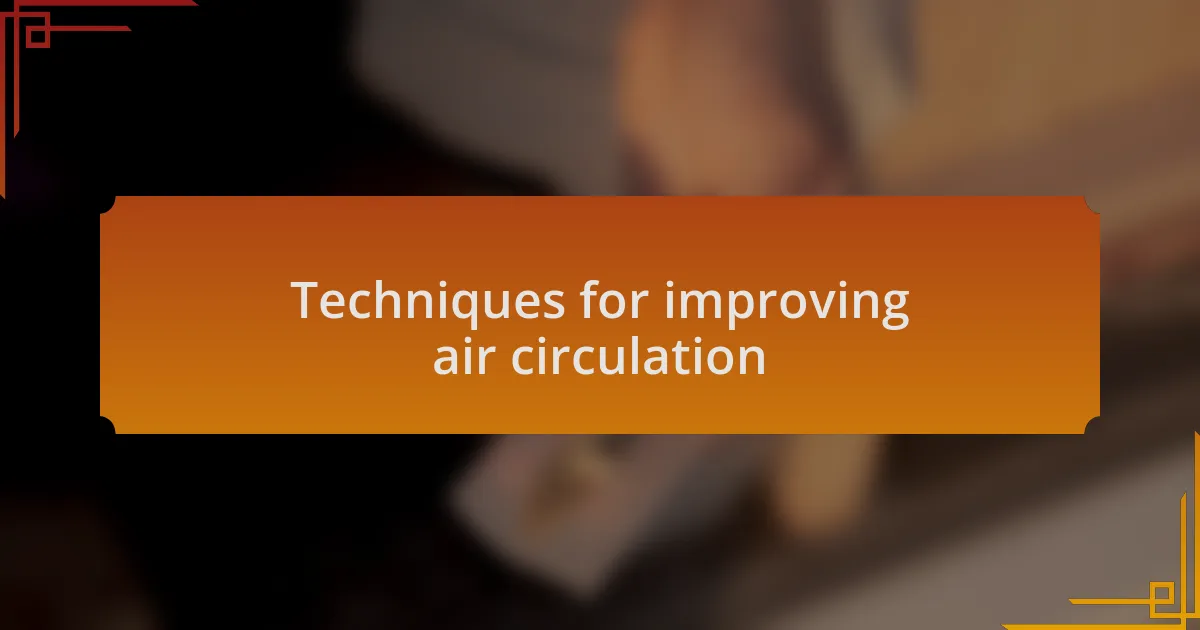Key takeaways:
- Effective air circulation is crucial for preventing humidity issues and promoting plant health, as stagnant air can lead to mold and poor growth.
- Strategic fan placement and airflow management, including the use of oscillating fans and ducting, significantly improve air movement and reduce hot spots.
- Dehumidifiers enhance airflow and help maintain optimal humidity levels, creating a stable environment that supports healthier plants.
- Regular evaluation of air circulation, including temperature and humidity checks, as well as observing plant responses, is essential for maintaining a thriving grow space.

Understanding air circulation
Air circulation is the heartbeat of any cannabis grow environment. I’ve often found myself caught off guard by how much it can affect plant health and yield. When I first started growing, I underestimated the impact of stagnant air; the difference was truly eye-opening as I watched plants suffering from mold and poor growth.
You might wonder, what exactly happens when air circulation is inadequate? For me, it meant learning the hard way that plants need fresh air to thrive—not just for carbon dioxide intake but also to prevent humidity build-up. I recall a grow where I failed to set up enough airflow, leading to a frustrating bout of powdery mildew that wiped out a significant part of my crop. That experience taught me the importance of consistent air movement and the use of fans.
Understanding air circulation is about recognizing its role in temperature control, humidity balance, and even nutrient uptake. I remember a moment of clarity when tweaking my ventilation system led to a noticeable uptick in plant vigor. It just goes to show that paying attention to airflow can transform an ordinary grow setup into a thriving garden.

Techniques for improving air circulation
Creating a well-ventilated space is essential for a healthy grow. One technique I swear by is strategically placing oscillating fans throughout the room. It’s fascinating how just a little movement can eliminate hot spots and distribute air evenly. I still remember the first time I tried this; watching my plants perk up after just a day was a rewarding moment that reinforced the importance of airflow in my setup.
Another effective method I’ve implemented is using ducting to manage airflow more efficiently. By directing air from outside into my grow space, I noticed a significant decrease in humidity levels, preventing unwanted mold. I recall a particularly humid summer when I struggled with excess moisture—installing ducting not only improved my plants’ health but also gave me peace of mind. How often do we overlook the simple solutions that can lead to substantial improvements?
Don’t underestimate the power of exhaust fans either. I’ve seen firsthand how they can dramatically lower temperatures and remove stale air. There was a time I had a single fan that vented my entire space, but once I upgraded to a larger unit, it transformed everything. I was amazed at how quickly the space felt refreshed and revitalized. Have you ever noticed how a little fresh air can invigorate not just your plants but yourself as well? Managing proper air circulation is a game changer.

Optimizing fan placement
Optimizing your fan placement can truly revolutionize your grow room. I often start by placing fans at strategic points, especially near the plants. One time, I made the mistake of setting them too high, and I realized that the gentle breeze needed to reach the lower leaves. Adjusting the height made a world of difference—it’s like the plants were finally getting the hug of airflow they desired.
Consider the direction of airflow as well. I learned this the hard way during my early days; I had all my fans blowing in the same direction, which created a sort of stagnant zone. By alternating the fans to create a circular airflow, I noticed a remarkable improvement in the overall health of my plants. Have you tried creating these airflow patterns?
Moreover, I always ensure my fans can work effectively without obstruction. It seems like a small detail, but once, I discovered that a few plant leaves were blocking one fan. After removing the obstruction, the difference was immediate. This reinforced the idea that even minor adjustments in fan placement can lead to significant changes in air circulation and plant vitality.

Using dehumidifiers for airflow
Using dehumidifiers can be a game-changer when it comes to improving airflow in your grow space. I remember the first time I introduced a dehumidifier into my routine; the difference was palpable. It not only helped to regulate humidity levels but also enhanced air circulation, allowing my plants to thrive. Do you ever notice how stagnant air can lead to mold or pests? I certainly do, and that’s when I realized the importance of maintaining an optimal environment.
A dehumidifier doesn’t just take moisture out of the air; it actively helps in preventing air from becoming too dense and musty. I noticed that with reduced humidity, the air felt lighter and more breathable, which, in turn, encouraged better airflow from my fans. This little machine became one of my most trusted allies in achieving a well-ventilated grow room. Have you thought about how a tiny change could have such a major impact?
Beyond just humidity control, dehumidifiers can help create a more stable environment for your plants. I once had a difficult time managing high humidity levels, and introducing a dehumidifier helped maintain consistency. The result? Healthier plants that were less prone to disease. It’s amazing how one tool can make such a profound impact on your growing experience.

Personal tips for maximizing circulation
One of my favorite tips for maximizing air circulation is positioning fans strategically. I remember setting up my first grow room and thinking I could just point fans in any direction. It wasn’t until I took the time to analyze airflow patterns that I realized how critical proper placement is. Have you ever sat in a corner of a room where you felt a breeze, only for it to vanish when you shifted position? That’s similar to how plants react to circulating air. Directing fans towards the plants helps ensure that all areas receive adequate airflow, promoting even growth and preventing hot spots.
Additionally, I’ve found that incorporating oscillating fans can make a significant difference. Shortly after adding a couple of these fans, I noticed improved movement in the air throughout the entire space. They simulate natural wind patterns, which can strengthen stems and enhance nutrient uptake. Isn’t it fascinating how little tweaks can lead to noticeable changes? Just think about the benefits of mimicking nature in your grow environment—it keeps your plants healthier and more resilient.
Lastly, I can’t emphasize enough the importance of keeping vents clean and unobstructed. A few months ago, I neglected to clear away some dust and debris from my air filters, and it quickly became apparent when the airflow started to diminish. It made me realize how vital maintenance is in fostering optimal conditions. Have you checked your vents lately? Ensuring they are clean allows for unrestricted airflow and will definitely contribute to a healthier grow environment.

Evaluating air circulation effectiveness
When evaluating air circulation effectiveness, I often turn to temperature and humidity measurements as key indicators. In one of my earlier grow projects, I relied solely on my intuition regarding airflow, but when I finally took the time to invest in a hygrometer and thermometer, the difference was astonishing. The readings revealed hot and humid spots that I hadn’t felt at first touch yet were detrimental to my plants. Have you ever overlooked a subtle shift in your environment only to discover it’s been causing issues?
Another aspect I focus on is the plants’ response to airflow, which can be incredibly telling. For example, I once noticed that some of my plants were stretching desperately towards my fan, a sign they were not getting enough circulation. It was almost like they were reaching out for help! Adjusting my fan’s angle and intensity not only improved their stance but also noticeably enhanced their overall health, which was rewarding to witness. Isn’t it amazing how attentive observation can lead to such a transformative impact?
Lastly, I advise conducting a simple test: walk through your grow space and feel the air movement. I remember one instance when I felt uneven airflow along the edges of my room. It was like a light bulb went off—this was the perfect cue to reposition my fans. Addressing those areas became a game changer. Have you taken a moment to feel your environment and assess if every corner of your grow space is benefitting from adequate air circulation? Sometimes, it’s the hands-on approach that reveals what technology can miss.